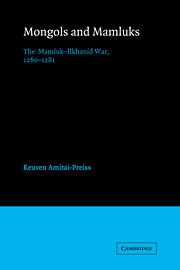Book contents
- Frontmatter
- Contents
- List of illustrations
- Preface
- List of abbreviations
- Notes on dates and transliteration
- Introduction
- 1 The historical background
- 2 The battle of ʿAyn Jālūt
- 3 The formulation of anti-Īlkhānid policy
- 4 The search for a second front
- 5 Military and diplomatic skirmishing
- 6 The secret war
- 7 Baybars's intervention in Seljuq Rūm
- 8 Baybars's posthumous victory: the second battle of Homs (680/1281)
- 9 The Mamluk–Īlkhānid frontier
- 10 Mamluks and Mongols: an overview
- Maps
- Genealogical Tables
- Glossary
- Bibliography
- Index
1 - The historical background
Published online by Cambridge University Press: 23 November 2009
- Frontmatter
- Contents
- List of illustrations
- Preface
- List of abbreviations
- Notes on dates and transliteration
- Introduction
- 1 The historical background
- 2 The battle of ʿAyn Jālūt
- 3 The formulation of anti-Īlkhānid policy
- 4 The search for a second front
- 5 Military and diplomatic skirmishing
- 6 The secret war
- 7 Baybars's intervention in Seljuq Rūm
- 8 Baybars's posthumous victory: the second battle of Homs (680/1281)
- 9 The Mamluk–Īlkhānid frontier
- 10 Mamluks and Mongols: an overview
- Maps
- Genealogical Tables
- Glossary
- Bibliography
- Index
Summary
Another decree is that [the Mongols] are to bring the whole world into subjection to them, nor are they to make peace with any nation unless they first submit to them …
John of Plano Carpini (ca. 1247)The Mongols and their conquest of southwest Asia
The Mongol Empire was founded in the late twelfth and early thirteenth centuries by Temüchin, later known as Chinggis Khan (died AD 1227), who united the Mongolian and Turkish-speaking tribes of the eastern Eurasian steppe and forged an empire which within the span of two generations was to stretch across Asia. Having put the Inner Asian steppe under his sway and obtained the submission of the Tanguts of the Hsi-Hsia state in northwest China, Tibet and Chinese Turkestan (1209), Chinggis Khan commenced his campaign against the north Chinese state of the Chin in 1211. While this conquest was not yet completed by the end of the decade, it was well enough along for Chinggis Khan to turn his attention to the west. One of his generals had already defeated the ruler of the Qara-Khitai in western Turkestan, obliterated this state and integrated its territory into the Mongol Empire.
In 1219, Chinggis Khan launched a massive offensive against the Khwārazm-shāh, who controlled most of the eastern Islamic world. The campaign had been sparked off by the Khwārazm-shāh's truculent attitude towards the Mongols and by his governor's murder of several hundred Muslim merchants under Mongol protection.
- Type
- Chapter
- Information
- Mongols and MamluksThe Mamluk-Ilkhanid War, 1260–1281, pp. 8 - 25Publisher: Cambridge University PressPrint publication year: 1995

